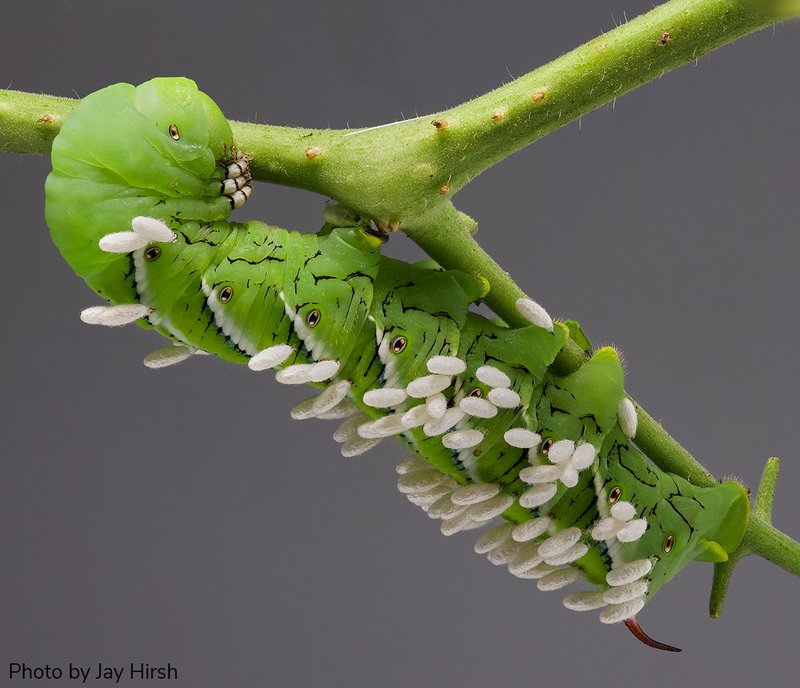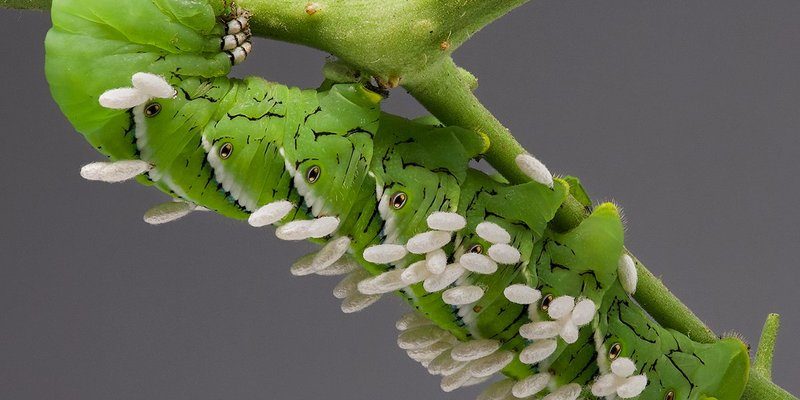
So, let’s delve into this natural method of pest control. Picture a garden bustling with life, where beneficial insects do their work seamlessly. Using parasitic wasps is like inviting nature’s team of exterminators to your yard. But how does this all work? Let’s break it down, step by step.
Understanding Hornworms: The Garden Pests
Hornworms are the larvae of certain moths, primarily the **tobacco hornworm** and the **tomato hornworm**. These caterpillars can grow up to 4 inches long and are notorious for their voracious appetites. They blend right into the leaves of your plants, making them difficult to spot until significant damage has been done. Imagine walking into your garden and discovering that your prized tomato plants have been reduced to skeletons overnight!
Recognizing these pests is crucial for effective control. Hornworms have a distinctive look: they’re usually green with white or yellow stripes and have a horn-like projection on their rear end. You might be wondering why they can be such a problem. Well, they can defoliate entire plants, stunting growth and reducing yields. This is where the **parasitic wasps** come into play.
What Are Parasitic Wasps?
Parasitic wasps are small insects, often less than an inch long, that play a vital role in controlling pest populations. There are several species, with some specifically targeting hornworms. These wasps don’t just feed on pests; they actually lay their eggs inside or on the larvae. Once the wasp eggs hatch, the larvae feed on the host, ultimately killing it. You could say that the wasps are nature’s hitmen—but in a good way!
Let’s make it clearer: think of parasitic wasps like tiny detectives, scouting out hornworms and quietly working to eliminate them. Their lifecycle is fascinating. First, they search for hornworms, then they insert their eggs into them. As those wasp larvae grow, they consume the hornworm from the inside. While it sounds gruesome, it’s a natural form of pest control that keeps ecosystems in balance.
How Do Parasitic Wasps Help Control Hornworm Populations?
Using parasitic wasps to control hornworms is a classic example of *biological control*, which utilizes natural predators to manage pest populations. When released into your garden, these wasps find and target hornworms, laying their eggs and significantly reducing their numbers. This can help restore harmony in your garden without resorting to chemical insecticides that can harm beneficial insects and the environment.
One of the biggest advantages of using parasitic wasps is their specificity. Most strains primarily target hornworms and won’t affect other insects, including pollinators like bees. Let’s be honest, maintaining that balance is vital for a thriving garden. You wouldn’t want to eliminate the good bugs while trying to get rid of the bad ones, right?
Another cool thing about these wasps is their reproductive strategy. A single female wasp can lay dozens of eggs, leading to rapid population growth in control efforts. It’s like having a small army on your side, all ready to tackle those hornworms.
Releasing Parasitic Wasps in Your Garden
If you’re interested in using parasitic wasps for hornworm control, you’ll want to know how to get started. First, you can purchase them from reputable suppliers or garden centers. Look for varieties like **Cotesia glomerata** or **Microplitis croceipes**, which are known for targeting hornworms.
Once you have your wasps, timing is essential. The best time to release them is during the early stages of hornworm infestation, ideally when you see the first signs of hornworms munching on your plants. Follow these steps for a successful release:
- Choose a cool, cloudy day: This helps the wasps acclimate better.
- Release near infested plants: This increases their chances of finding hornworms.
- Provide shelter: If possible, use insect mesh or row covers to protect them until they establish themselves.
After releasing the wasps, keep monitoring your garden. You may start to notice fewer hornworms and even see the wasps in action. It can be a bit like watching a nature documentary unfold right in your backyard!
Potential Challenges and Considerations
While the idea of using parasitic wasps sounds great, there are some challenges to consider. First, you may not notice immediate results. It takes time for the wasps to find and target hornworms, especially if the infestation is severe. Patience is key here!
Another challenge is ensuring that these wasps establish themselves in your garden. Factors like weather, availability of hornworms, and other environmental conditions can impact their success. Sometimes local populations of hornworms can be higher than what the wasps can control.
Also, keep in mind that these wasps might not be the best solution for everyone. If you have a small garden or a limited pest problem, using parasitic wasps might not be necessary. Sometimes, hand-picking hornworms or using other organic methods can be more straightforward.
Comparing Parasitic Wasps to Other Control Methods
You might be wondering how parasitic wasps stack up against other pest control methods. Let’s compare a few options.
- Chemical pesticides: While these can be effective, they pose risks to beneficial insects and can contribute to environmental pollution. Parasitic wasps offer a more eco-friendly approach.
- Hand-picking: This is a straightforward method, especially for small gardens, but can be time-consuming. If you have a larger area, wasps can be more efficient.
- Companion planting: This involves planting certain crops together to deter pests. While useful, it may not specifically target hornworms like parasitic wasps do.
Ultimately, the choice comes down to your gardening style and needs. Combining methods can also lead to better results!
Embracing Biological Control for a Healthier Garden
Using parasitic wasps to control hornworm populations is a fantastic way to promote a healthier garden ecosystem. Not only does it help reduce pest numbers, but it also supports beneficial insects. It’s an organic approach that fits with many gardeners’ philosophies of working with nature instead of against it.
As you consider this method, it’s important to stay informed. Understanding how parasites interact with their hosts can help you appreciate the balance in your garden. Plus, there’s something satisfying about knowing that Mother Nature has a built-in solution to common problems.
In conclusion, integrating parasitic wasps into your gardening practices can lead to a vibrant and pest-managed environment. So next time you see those pesky hornworms, remember: nature has its own superheroes ready to swoop in and save the day!

